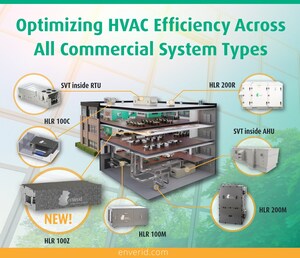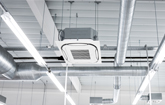enVerid Systems Urges Reevaluation of HVAC COVID-19 Strategies in Light of ASHRAE Epidemic Task Force's Latest Core Recommendations
Updated guidance focuses on controlling airborne infectious aerosol exposure via a mix of ventilation, filtration, and air cleaners while minimizing associated energy penalties
WESTWOOD, Mass., Jan. 25, 2021 /PRNewswire/ -- enVerid Systems, a leading provider of indoor air quality solutions, fully supports the ASHRAE Epidemic Task Force's (ETF) updated "Core Recommendations for Reducing Airborne Infectious Aerosol Exposure," and calls on office, school, and institutional building managers to reevaluate their HVAC strategies for mitigating COVID-19 in light of the updated guidance to ensure desired exposure reduction while minimizing associated energy penalties.
On Jan. 6, 2021 ASHRAE's ETF posted a refined and concise summary of its recommendations across its many detailed guidance documents, including its Commercial Guide and School Guide. As stated in the ASHRAE press release, the Core Recommendations are "based on the concept that ventilation, filtration and air cleaners can be combined flexibly to achieve exposure reduction goals subject to constraints that may include comfort, energy use and costs."
The Core Recommendations for Ventilation, Filtration, and Air Cleaning are the following:
- Provide and maintain at least required minimum outdoor airflow rates for ventilation as specified by applicable codes and standards.
- Use combinations of filters and air cleaners that achieve MERV 13 or better levels of performance for air recirculated by HVAC systems.
- Only use air cleaners for which evidence of effectiveness and safety are clear.
- Select control options, including standalone filters and air cleaners, that provide desired exposure reduction while minimizing associated energy penalties.
"With this important update, ASHRAE makes clear that buildings can achieve safe air exchange rates with a mix of ventilation, filtration, and air cleaners to mitigate aerosol transmission," said Christian Weeks, CEO of enVerid Systems. "Additionally, the ETF emphasizes that energy expenditure is a critical factor in determining an optimal HVAC strategy for COVID mitigation. We applaud the ETF's rigorous effort to evolve their recommendations to account for key operational considerations, and we encourage building managers to reevaluate their HVAC COVID-19 strategies to align with ASHRAE's updated guidance to deliver safe indoor air without the high energy penalty of ventilation-only approaches."
In the early days of the pandemic, the ASHRAE ETF released preliminary guidance that called for maximizing outside air ventilation. This strategy has several drawbacks including high energy penalties and increased carbon emissions. During an October webinar, Prof. William Bahnfleth, Chair of ASHRAE's Epidemic Task Force, explained that initial guidance from ASHRAE was very conservative without consideration for cost, operational, and seasonal weather impacts. Over time the ASHRAE ETF has evolved its guidance, and the Core Recommendations refine the ETF's findings into a streamlined prescription to mitigate the transmission of infectious airborne aerosols in commercial buildings.
According to Prof. Bahnfleth, "ASHRAE's Core Recommendations are based on an equivalent clean air supply approach that allows the effects of filters, air cleaners other removal mechanisms to be added together to achieve an exposure reduction target." Experts from Harvard Chan School of Public Health recommend 6 air changes per hour (ACH) as the ideal exposure reduction target for schools. Six ACH means the air inside building spaces will be exchanged for clean air once every 10 minutes. Clean air is defined as outside air or recirculated air that has been filtered by high-efficiency filters such as MERV-13 filters and local HEPA filters.
"We welcome the new ASHRAE ETF Core Recommendations, and the emphasis on a flexible combination of HVAC strategies to address indoor air quality allowing important considerations such as energy penalties, outside air quality and other factors to be part of the equation," said Robert Ioanna, Senior Principal at Syska Hennessy. "Today's priority is halting transmission of SARS-CoV-2. Tomorrow's will be ensuring HVAC systems address the dual priorities of pandemic proofing and maximizing energy efficiency – with the end goal of high IAQ, lower operating costs and reduced carbon emissions."
Industry Resources
enVerid continues to share a range of resources to help inform building engineers, owners, and consulting engineers about IAQ, infectious aerosols, and contaminants of concern.
Most recently, enVerid published the enVerid COVID-19 Energy Estimator, a free, open-source tool to help building owners, mechanical engineers, and facility managers evaluate the risk, costs, and carbon impacts of different ventilation and filtration approaches to reopen buildings safely. The Energy Estimator shows that installing high-efficiency filtration can be as effective and lower cost than increasing ventilation rates to achieve target air exchange rates to reduce bioaerosol exposure risk.
Additional resources for building managers and engineers include a White Paper on filtration and ventilation, a Guide for Improving Classroom Air Quality for COVID-19 Mitigation and a Webinar Series on COVID-19 & IAQ: New Best Practices that features ASHRAE ETF experts.
enVerid Products
enVerid's HVAC Load Reduction® (HLR) technology saves money for commercial property owners and occupiers by enabling the reduction of outside air without compromising indoor air quality. HLR technology does this by scrubbing indoor air of all molecular contaminants of concern. ASHRAE Standard 62.1 defines two procedures for mechanical ventilation: the Ventilation Rate Procedure (VRP) and the Indoor Air Quality Procedure (IAQP). Unlike VRP, which defines ventilation requirements based on space size and occupancy without accounting for the efficiency benefits of air cleaning technologies, IAQP is a performance-based ventilation approach that allows for lower outside air (OA), and therefore lower energy expense when air scrubbing technology is used.
Designing HVAC systems using IAQP combined with sorbent-based air cleaning and high-efficiency filtration significantly reduces first- and operating costs without increasing the risk of airborne transmission of viruses. For illustration, in a 100,000 ft2 office building in New York City, by reducing rather than increasing 10,000 CFM of OA, $500,000 can be saved on combined first costs and 20-year operating costs without increasing airborne virus transmission risk.
The enVerid Air Purifier is a ceiling mounted HEPA air filtration system with an ultraviolet germicidal irradiation (UVGI) sterilization lamp that has been shown to capture 99.99% of viruses including a surrogate for the COVID-19 virus. A low-cost, easy to install, and energy efficient solution, the enVerid Air Purifier is ideal for offices, classrooms, retail stores, and other commercial applications seeking to boost effective air changes per hour.
About enVerid Systems, Inc.
enVerid Systems helps buildings achieve ESG (Environmental, Social, and Governance), healthy building, and cost saving goals by improving indoor air quality while saving money and reducing energy consumption and carbon emissions. For new HVAC systems, enVerid's award-winning HVAC Load Reduction® (HLR) Modules enable immediate capital cost savings. HLR Modules also deliver up to 30% energy savings and superior indoor air quality in new and existing buildings. enVerid's air filtration products remove particulate and microorganism contamination from indoor air without the significant cost of upgrading mechanical systems and increasing mechanical ventilation rates. enVerid's products are deployed in commercial, academic, and government buildings globally. enVerid's HLR Modules are ASHRAE Standard 62.1, LEED, and WELL compliant and eligible for utility rebates. For more information, please visit https://enverid.com.
SOURCE enVerid Systems

Related Links
WANT YOUR COMPANY'S NEWS FEATURED ON PRNEWSWIRE.COM?
Newsrooms &
Influencers
Digital Media
Outlets
Journalists
Opted In





Share this article